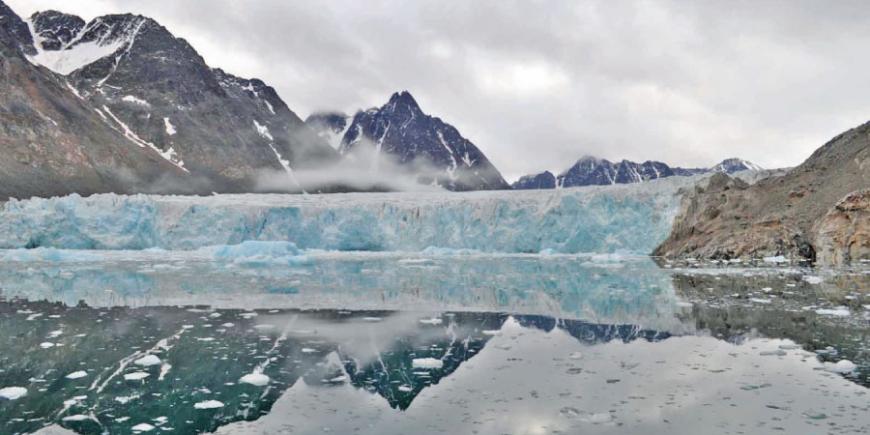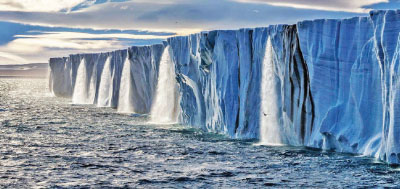
Continued from last week
In some places marvels of human engineering worsen effects from rising seas in a warming world. The system of channels and levees along the Mississippi effectively stopped the millennia-old natural process of rebuilding the river delta with rich sediment deposits. In the 1930s oil and gas companies began to dredge shipping and exploratory canals, tearing up the marshland buffers that helped dissipate tidal surges. Energy drilling removed vast quantities of subsurface liquid, which studies suggest increased the rate at which the land is sinking. Now Louisiana is losing approximately 25 square miles (65 square kilometres) of wetlands every year, and the state is lobbying for federal money to help replace the upstream sediments that are the delta’s lifeblood.
Local projects like that might not do much good in the very long run, though, depending on the course of change elsewhere on the planet. Part of Antarctica’s Larsen Ice Shelf broke apart in early 2002. Although floating ice does not change sea level when it melts (any more than a glass of water will overflow when the ice cubes in it melt), scientists became concerned that the collapse could foreshadow the breakup of other ice shelves in Antarctica and allow increased glacial discharge into the sea from ice sheets on the continent. If the West Antarctic ice sheet were to break up, which scientists consider very unlikely this century, it alone contains enough ice to raise sea level by nearly 20 feet (6 metres).
Even without such a major event, the IPCC projected in its 2001 report that sea level will rise anywhere between 4 and 35 inches (10 and 89 centimeters) by the end of the century. The high end of that projection—nearly three feet (a metre)—would be “an unmitigated disaster,” according to Douglas.
Down on the bayou, all of those predictions make Windell Curole shudder. “We’re the guinea pigs,” he says, surveying his aqueous world from the relatively lofty vantage point of a 12-foot-high (3.7-metre) earthen berm. “I don’t think anybody down here looks at the sea-level-rise problem and puts their heads in the sand.” That’s because soon there may not be much sand left.
Rising sea level is not the only change Earth’s oceans are undergoing. The ten-year-long World Ocean Circulation Experiment, launched in 1990, has helped researchers to better understand what is now called the ocean conveyor belt.
Oceans, in effect, mimic some functions of the human circulatory system. Just as arteries carry oxygenated blood from the heart to the extremities, and veins return blood to be replenished with oxygen, oceans provide life-sustaining circulation to the planet. Propelled mainly by prevailing winds and differences in water density, which changes with the temperature and salinity of the seawater, ocean currents are critical in cooling, warming, and watering the planet’s terrestrial surfaces—and in transferring heat from the Equator to the Poles.
Changes in water temperature and salinity, depending on how drastic they are, might have considerable effects on the ocean conveyor belt. Ocean temperatures are rising in all ocean basins and at much deeper depths than previously thought, say scientists at the National Oceanic and Atmospheric Administration (NOAA). Arguably, the largest oceanic change ever measured in the era of modern instruments is in the declining salinity of the sub polar seas bordering the North Atlantic.
Oceans are important sinks, or absorption centers, for carbon dioxide, and take up about a third of human-generated CO2. Data from the Bermuda monitoring programs show that CO2 levels at the ocean surface are rising at about the same rate as atmospheric CO2. But it is in the deeper levels where Bates has observed even greater change. In the waters between 820 and 1,476 feet (250 and 450 meters) deep, CO2 levels are rising at nearly twice the rate as in the surface waters.
“It’s not a belief system; it’s an observable scientific fact,” Bates says. “And it shouldn’t be doing that unless something fundamental has changed in this part of the ocean.”
While scientists like Bates monitor changes in the oceans, others evaluate CO2 levels in the atmosphere. In Vestmannaeyjar, Iceland, a lighthouse attendant opens a large silver suitcase that looks like something out of a James Bond movie, telescopes out an attached 15-foot (4.5-metre) rod, and flips a switch, activating a computer that controls several motors, valves, and stopcocks. Two two-and-a-half litre (about 26 quarts) flasks in the suitcase fill with ambient air. When the weekly collection is done, all the flasks are sent to Boulder, Colorado. There, Pieter Tans, a Dutch-born atmospheric scientist with NOAA’s Climate Monitoring and Diagnostics Laboratory, oversees a slew of sensitive instruments that test the air in the flasks for its chemical composition. In this way Tans helps assess the state of the world’s atmosphere.
By all accounts it has changed significantly in the past 150 years.
Walking through the various labs filled with cylinders of standardised gas mixtures, absolute manometres, and gas chromatographs, Tans offers up a short history of atmospheric monitoring. In the late 1950s a researcher named Charles Keeling began measuring CO2 in the atmosphere above Hawaii’s 13,679-foot (4,169-metre) Mauna Loa. The first thing that caught Keeling’s eye was how CO2 level rose and fell seasonally. That made sense since, during spring and summer, plants take in CO2 during photosynthesis and produce oxygen in the atmosphere. In the fall and winter, when plants decay, they release greater quantities of CO2 through respiration and decay. Keeling’s vacillating seasonal curve became famous as a visual representation of the Earth “breathing.”
Something else about the way the Earth was breathing attracted Keeling’s attention. He watched as CO2 level not only fluctuated seasonally, but also rose year after year. The carbon dioxide level has climbed from about 315 parts per million (ppm) from Keeling’s first readings in 1958 to more than 375 ppm today. A primary source for this rise is indisputable: humans’ prodigious burning of carbon-laden fossil fuels for their factories, homes, and cars.
Exactly how large that effect might be on the planet’s health and respiratory system will continue to be a subject of great scientific and political debate—especially if the lines on the graph continue their upward trajectory.
There are no words, though, to describe how much, and how fast, the ice is changing. Researchers long ago predicted that the most visible impacts from a globally warmer world would occur first at high latitudes: rising air and sea temperatures, earlier snowmelt, later ice freeze-up, reductions in sea ice, thawing permafrost, more erosion and increases in storm intensity. Now all those impacts have been documented in Alaska. “The changes observed here provide an early warning system for the rest of the planet,” says Amanda Lynch, an Australian researcher who is the principal investigator on a project that works with Barrow’s residents to help them incorporate scientific data into management decisions for the city’s threatened infrastructure.
Before leaving the Arctic, I drive to Point Barrow alone. There, at the tip of Alaska, roughshod hunting shacks dot the spit of land that marks the dividing line between the Chukchi and Beaufort Seas. Next to one shack someone has planted three eight-foot (2.4-meter) sticks of white driftwood in the sand, then crisscrossed their tops with whale baleen, a horny substance that whales of the same name use to filter life-sustaining plankton out of seawater. The baleen, curiously, looks like palm fronds.
So there, on the North Slope of Alaska, stand three makeshift palm trees. Perhaps they are no more than an elaborate Inupiat joke, but these Arctic palms seem an enigmatic metaphor for the Earth’s future.
